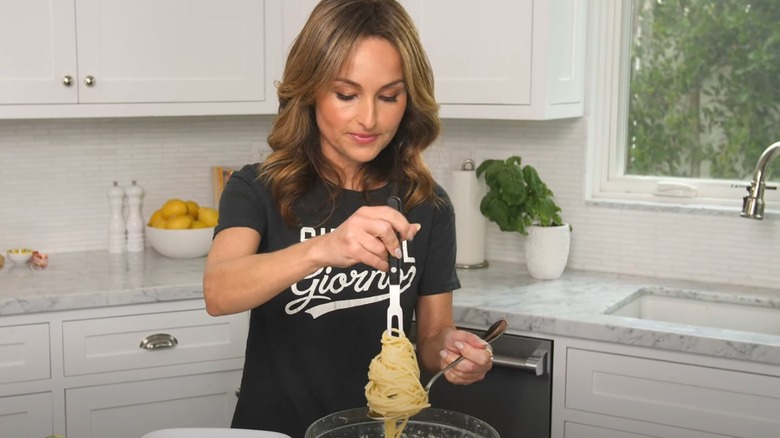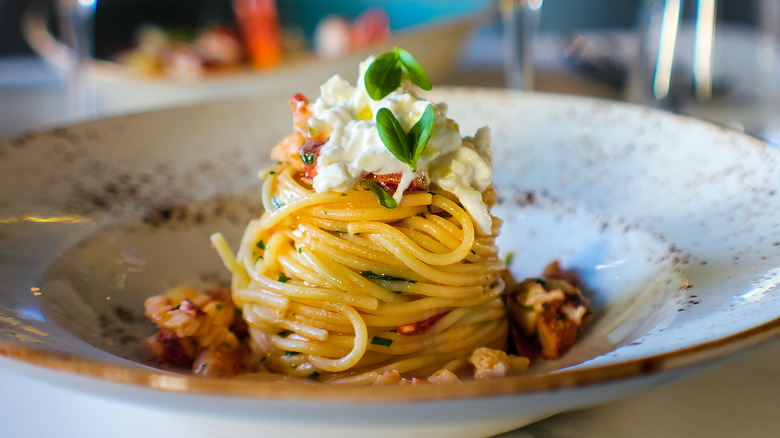The Unexpected Utensil Giada De Laurentiis Uses To Plate Pasta
Part of the appeal of dining out is that the food is presented so beautifully. Rather than plopping an abundant scoop of pasta onto your plate, chefs frame the food since we also eat with our eyes. While restaurant-quality pasta starts by sautéing al dente noodles with its sauce in a skillet (not combining the two on the plate), it somehow tastes better when the sauced pasta is piled high in a fancy nest.
This plating technique is also a great way to make a smaller serving look bigger by tricking the eye into looking up instead of at the blank space on the plate or shallow bowl. While commercial kitchens traditionally use a pair of long, tweezer-like tongs that resemble a tuning fork for precision plating, home cooks can replicate restaurant-quality plating with an often underused utensil they probably have in their kitchen.
In a YouTube video, chef Giada De Laurentiis demonstrates how to plate pasta al limone into a tall nest using a carving fork, commonly sold with knife or carving sets. If you don't have a carving fork, this impressive presentation can still be achieved using tongs.
How to plate spaghetti
Similar to how you may use a spoon to twirl a mouthful of pasta around a fork, De Laurentiis uses a carving fork and a large serving spoon to twirl spaghetti onto a serving plate. With two long tines, a carving fork lets cooks coil several inches of pasta into a tall mound.
To impress your guests the next time you prepare spaghetti, grab a pasta serving with the fork and place the serving spoon underneath to keep the pasta in place. Spin the fork until the pasta is tightly coiled around it. If you don't have a serving spoon large enough, a soup ladle can be used.
Use the spoon or ladle to help guide the spaghetti to the serving plate. Once the pasta is in the center of the plate, the carving fork can be slowly lifted, leaving an impressive tall nest of pasta.
Long tongs can be used instead of a carving fork, but the presentation may not be as high. Be sure to keep the tongs closed as you twirl until you are ready to plate. Once the pasta is nestled on the plate, slightly open the tongs to retract them without fully opening them up, causing the walls of the pasta to collapse.
It takes some practice. And, if the pasta is dressed in a red sauce, you may need to wipe a few splatters before serving.
Pasta plating tips to keep in mind
For the perfect texture, chefs slightly undercook pasta and allow it to finish cooking for a minute or two in the sauce. The cooked pasta can be strained in a colander or collected from the boiling water using tongs and placed directly into the simmering sauce. Whichever method you prefer, be sure to save about a cup of the pasta cooking water.
This starchy water helps the sauce cling to the pasta and emulsify the sauce. While it's ultimately a personal preference, pasta isn't meant to be drowned in sauce, and a soupy spaghetti bolognese won't hold its shape on the plate when twirled.
When the sauce clings to the noodles, it's easier to coil tightly for a taller presentation. Refrain from tossing cooked pasta in olive oil before saucing. It will prevent the sauce from sticking.
To plate short or tubed pasta like penne and orecchiette, use a round cookie cutter to build the pasta similarly on the plate. Place a four or five-inch cookie cutter in the center of your plate, add the lightly dressed pasta, and remove the cookie cutter before serving. A rinsed-out tuna fish tin can with both the top and bottom removed can also be used as a mold.



